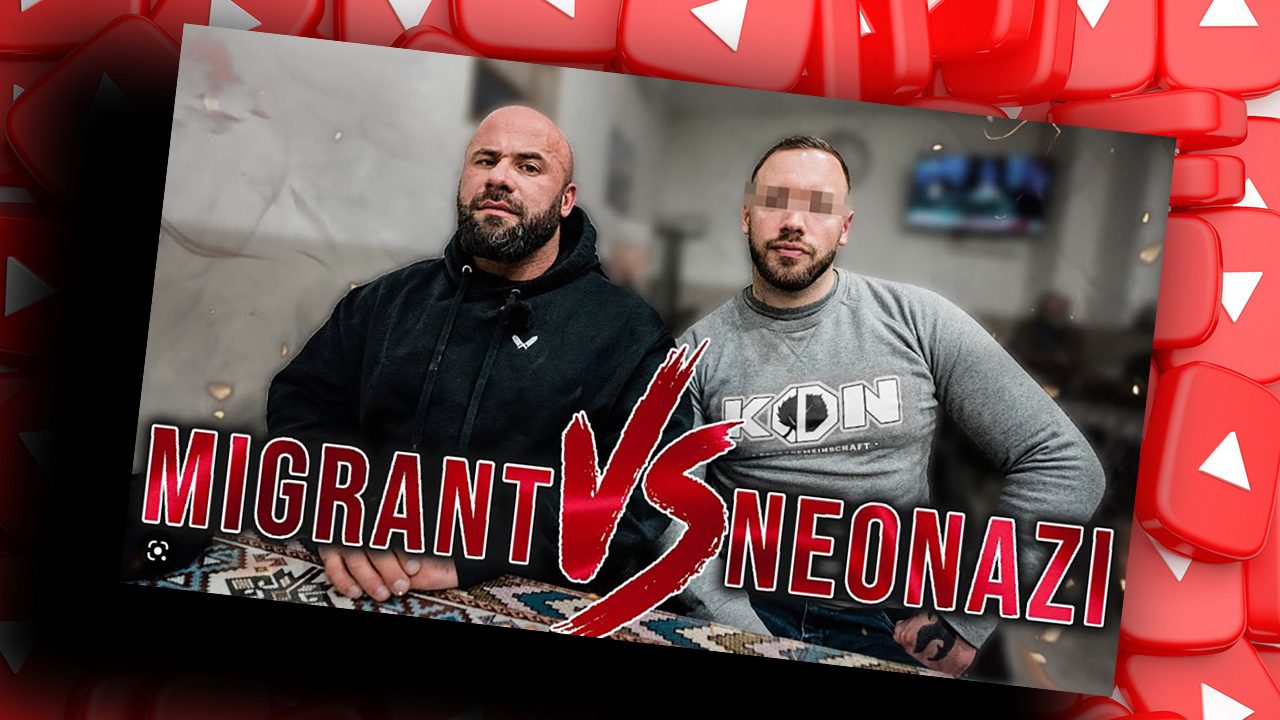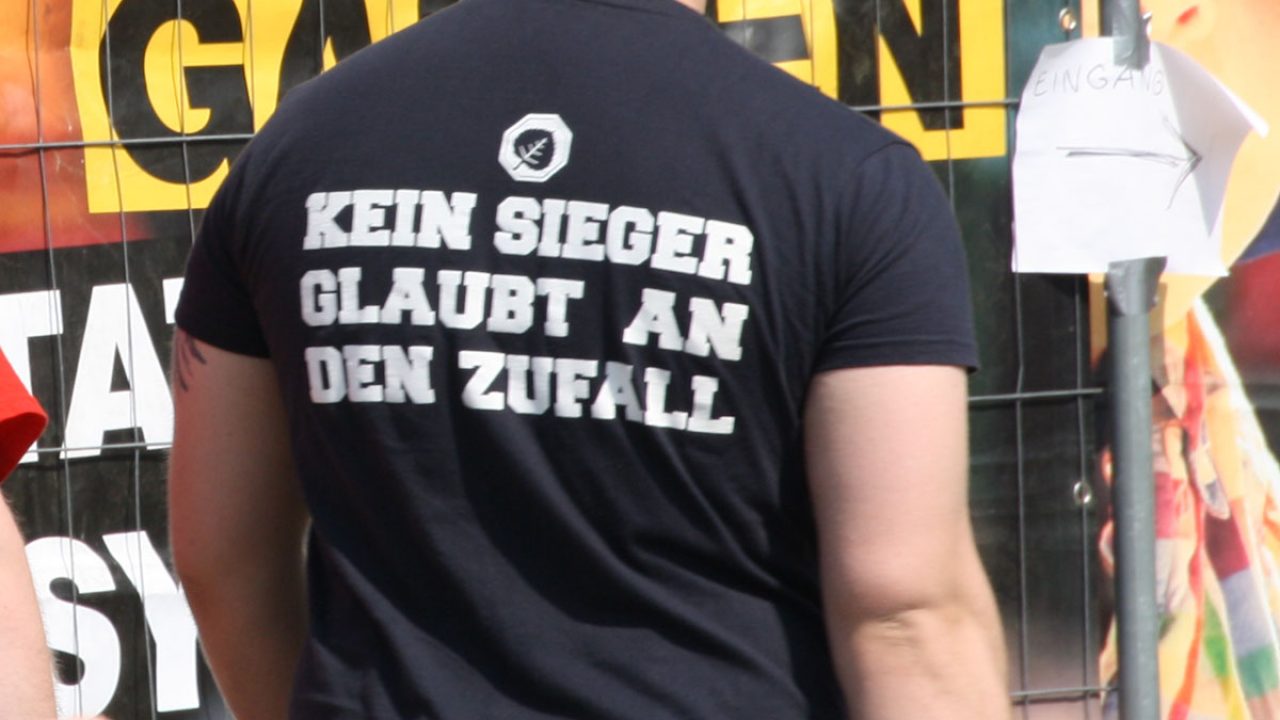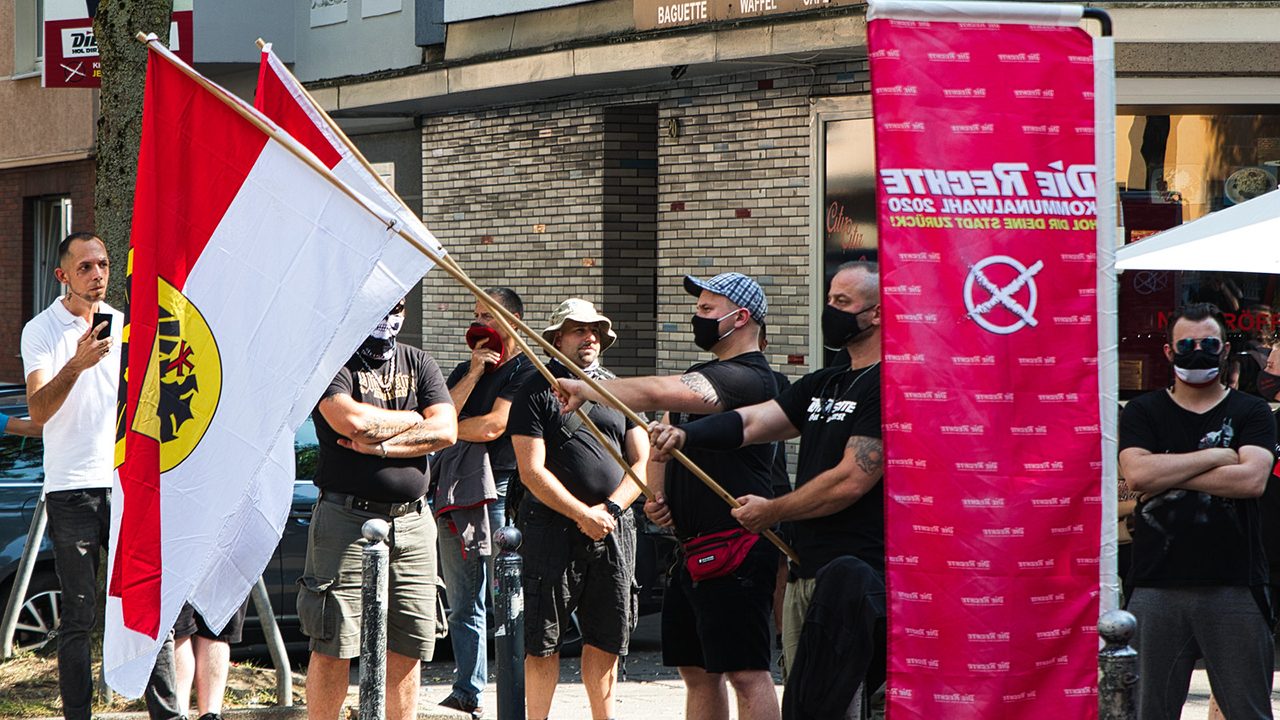
Translation: Joe Keady
In a YouTube video that was released in early January, a Muslim YouTuber interviews Dortmund, Germany-based neo-nazi Steven Feldmann. They meet on Emserstrasse, a street in Dorstfeld, the city’s so-called “Nazi neighbourhood”. Feldmann can disseminate his far-right ideology there without any filters at all. A few weeks later, another YouTuber with a large following, TomSprm, also goes to the Nazi neighbourhood to talk to Feldmann. And once again, in exchange for a lot of dangerous fascist and racist propaganda, no insights are gained.
YouTube is an extremely popular medium, particularly for young people. For many of them, its personalities have long been rock stars. YouTubers are often role models, best friends, big sisters, and surrogate parents all rolled into one. They speak directly to their fans and often give them the feeling that they have a completely personal relationship. This is all the more problematic when far-right propaganda is disseminated on major channels.
In early January, a YouTube channel with 340,000 subscribers published a nearly 25-minute video in which food influencer Ahmed Sharif met with neo-nazi Steven Feldmann in Dorstfeld. During the interview, Feldmann is flanked by neo-nazi Alexander Deptolla, a major figure in the scene, who also filmed the meeting for his own assurance. Deptolla is regarded as one of the main organisers behind the neo-nazi MMA tournament called Kampf der Nibelungen (Battle of the Nibelungs). Throughout the entire interview, Feldmann was allowed to be on camera wearing a sweatshirt promoting the far-right event.
Yes, even some neo-nazis eat Turkish food
While eating kebab together, Feldmann was then able to talk freely, putting his racist worldview on display unfiltered. He talked about the alleged facts that “natives” are hard to find anymore and that migrant youth are almost all criminals, despite the fact that he spent several years in prison himself. He regards children who have one German parent and one foreign parent as “wrong”.
In the video, Feldmann states quite openly that he supports “repatriation of all foreigners living in Germany”. Sharif moves to take a bite of his kebab, but stops to ask if he would also be included in the repatriation that Feldmann wants to see, given that his family is entirely from Lebanon. Feldmann answers that, yes, he would be, if it were up to him. The neo-nazi is then allowed to share his racist views on cultural inequality and degrees of difference, depending on the region where Feldmann locates a person.
The video satisfies a voyeuristic urge for viewers and offers an insight into the banality of evil, but we learn nothing new in the process. Everything that there is to say about far-right ideology and neo-nazi lifestyles has already been said and written by countless people who are not far-right ideologues. And there is also the option of speaking with people who have left the scene.
“Reminiscent of debates from 2017”
“Some of the current videos on YouTube take you back to debates from 2017”, says Mick Prinz, head of the Amadeu Antonio Stiftung’s Good Gaming – Well Played Democracy project. “People are discussing how useful it is to talk to people on the far right again.” The book Mit Rechten reden – ein Leitfaden (Talking to Right-Wingers: A Guide) was published in 2017. It was intended as a kind of plea to engage in dialogue with members of the so-called “new” right who oppose democracy and Germany’s constitutional republic . As erroneous and dangerous as that approach was even then, it is no better to engage in dialogue with nationalists today.
Exclusion and no discussion on equal terms
At least the YouTuber says over the closing credits that “Steven’s ideology is really hard to bear”. Nonetheless, the question remains why he exposed himself to the nazi at all and allowed his YouTube channel to be used to spread far-right ideology without assessing or refuting it. Because one thing needs to be clear: you don’t engage in dialogue with nazis, and certainly not on equal terms.
There is a good reason why anti-constitutional, racist, and antisemitic far-right publications usually aren’t on display at the corner newsstand and the corresponding accounts are regularly terminated on social media. Disseminating far-right content normalises it. Fascists and others who oppose democracy do not believe in the equality of all people. Their understanding of the concept of a nation is based on their assumption of blood purity. People with those kinds of views cannot be equal discussion partners. Conversations like that simply have no basis in human rights.
Another “I’m so brave and talked to a Nazi so you don’t have to” video was released in late January, although it was deleted again a few hours later, apparently by the channel’s administrator. Here as well, Steven Feldmann took center stage, this time wearing another Kampf der Nibelungen sweatshirt.
This time, Feldmann was interviewed by YouTuber TomSprm, whose channel has over 600,000 subscribers. In all, his videos have been watched over 83 million times. TomSprm mostly produces “satirical” man-on-the-street interviews, occasionally with “funny” fart noise overdubs that are meant to appeal primarily to young people.
You might think that he may not be the most appropriate person to conduct a critical interview with an organised neo-nazi. Yet, inspired by Ahmed Sharif’s video, he also met with Feldmann in Dortmund.
In this case, the main question is why Feldmann turned to the extreme right. This video also fails to deliver exciting answers or any kind of insight. Instead, Feldmann used his platform to glorify national socialism unopposed, because what he heard is that people at the time were trying to use their policies to help Germany. TomSprm then gladly listens to far-right music. And the neo-nazis – this time Feldmann has a half dozen comrades with him – complain that some of their favourite neo-nazi songs have been banned.
Finally, neo-nazi Sven Skoda, a leading figure in the Western German neo-nazi scene, is allowed on camera. He reiterates that “we hate this state”. Starting from an obvious assumption that “both sides are bad”, the YouTuber ultimately asks whether these organised neo-nazis are afraid of their opposition. Skoda happily takes the opportunity to frame himself as the victim of the violent antifa by describing an attack against him. By contrast, daily right-wing attacks are never mentioned.
“Creators establish talk formats in which far-right populist or extreme right-wing statements are presented as supposedly legitimate”, says platform researcher Mick Prinz. “We often look for critical assessments or protection of the people affected and find nothing.”
The main question remains: why? Why does a neo-nazi with neo-nazi ideology need to be offered a platform? What value do videos like these offer? In both cases, the answer is: none. These kinds of videos presumably get content creators clicks, but they are incredibly harmful. That is because the desire to use them to demystify far-right ideology fails and, instead, neo-nazis are able to disseminate their propaganda unfiltered and, to some extent, make them socially acceptable.

